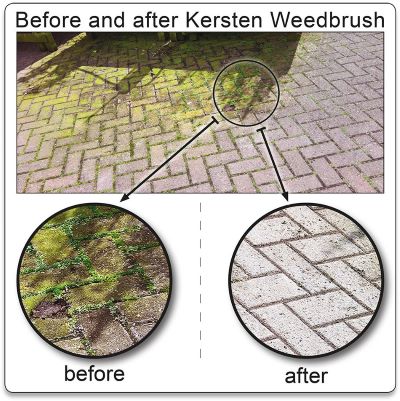Moss Brushes, Weed Brushes & Weed Rippers - What's the difference?
There are several different terms commonly used to describe weed brushes. In this article we look at the different terms and why you might want one type over another...
The different uses between Moss Brushes, Weed Brushes and Weed Rippers
There doesn't seem to be a good Dictionary definition for the terms; Moss Brush, Weed Brush and Weed Ripper, so I thought it would be useful to create a short guide to the terms and how they are most frequently used.
In essence all three terms describe a brush, normally using metal filling, to remove different types of vegetation and soil from hard surfaces. Some people use the terms completely interchangeably, but often they are used to describe the most suitable application for the type of brush in question.
Moss Brushes
The term moss brush is usually used to describe the lighter duty or more domestic machines on the market. Moss is a very easy thing to remove from most hard surfaces. Mosses are Non-Vascular plants, meaning they do not have a root system, instead using "rhizoids" - small hair like structures, whose main job is to anchor the plant in soil. Because of this they are not anchored very deeply and the soil they are in remains fairly friable. This makes it easy to brush off a surface with a stiff brush and relatively little power.
Brushes designed only for removing moss can therefore be lighter duty than those used for other purposes. Some brushes on the market described as moss brushes are belt driven; This system is not designed for heavier duty soil and weed removal, as the belts will quickly start to slip and burn out as the going gets tough. The belt driven machines also have little angling or height adjustment capability to deal with different surfaces.
A typical example of a job that might be handled with a Moss Brush can be seen below... although this was achieved with our Weedo II.

Weed Brushes
The term weed brush is used to describe an all-round brush that will remove more stubborn weeds and heavier soil build up, as well as moss and other lighter debris. This is the sweet spot for the Kersten K-series machines and the Weedo II. Plants with root systems are better anchored to the surface than mosses and therefore require more power and more precise angling or height adjustment capability to achieve the desired result on a variety of surfaces; including block paving, tarmac and other hard surfaces.
Weed brushes will also do a good job of path edging, becoming especially capable when they are driven by a machine with larger horsepower. Path edging requires a lot of torque, and this can be tiring on the operator, so The UBS Series power units are designed with wheel motors that hold the machine in a straight line and allow you to steer with your fingertips. Weed brushes come in all shapes and sizes, with options available for tractor mounting, as well as pedestrian machines.
A typical example of the type of job this will achieve can be seen below.
Weed Rippers
The term weed ripper can be used synonymously with Weed Brush. However, it sometimes refers to a type of weed brush fitted with cable brushes, rather than tufts. These brushes are slightly more effective ar ripping excess turf away from the main body of soil for path edging... However, they are also more likely to cause damage to hard surfaces such as block paving if they are not set up correctly. The stiffer cable brushes can more easily scratch bricks and tarmac than the tuft type brushes. The tuft or "versa" type brushes are also better at cleaning the surface, which usually results in a better finish.
A typical job for the weed ripper can be seen below;
 400.jpeg)
More information on our range of weed brushes can be found in the Mechanical Weed Removal section of our website.
If you would like more information or a demonstration of our machines please get in touch and we will be happy to help.
No comments yet. Login to start a new discussion Start a new discussion